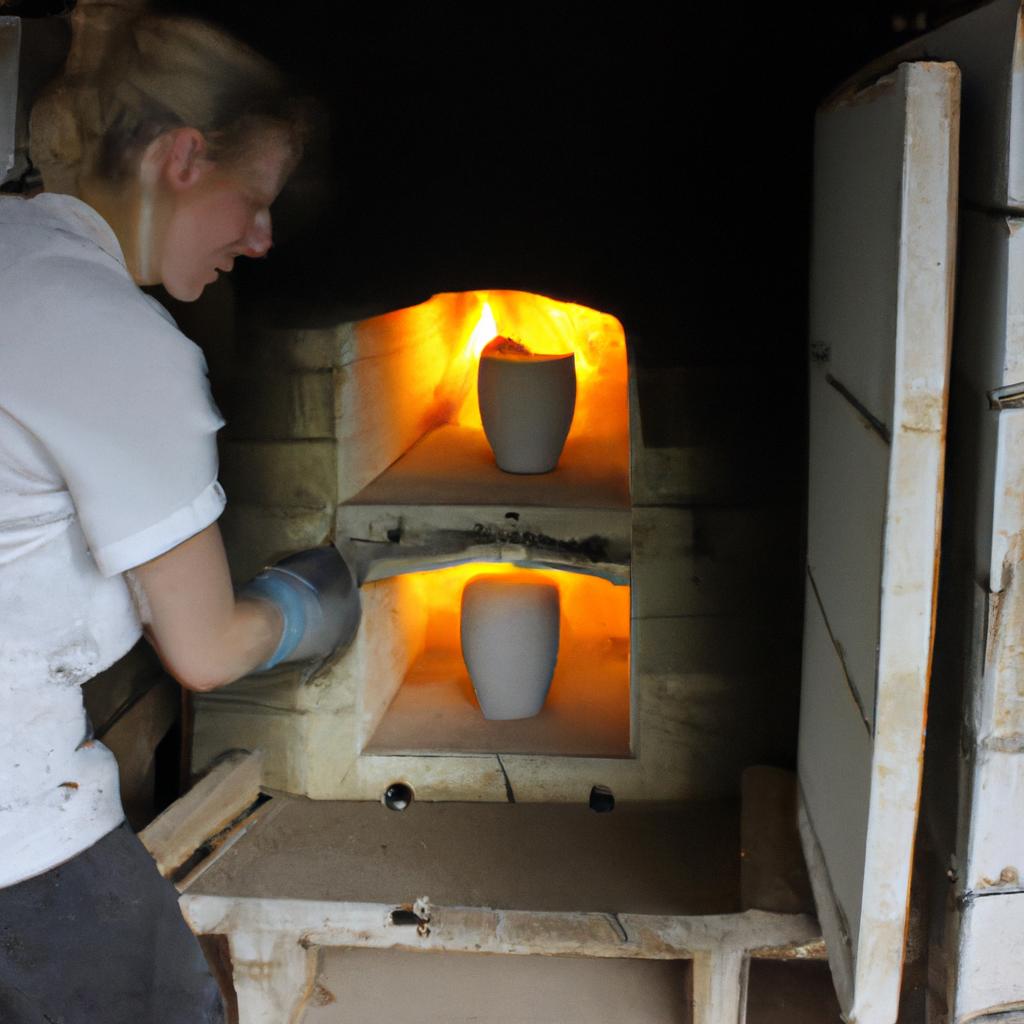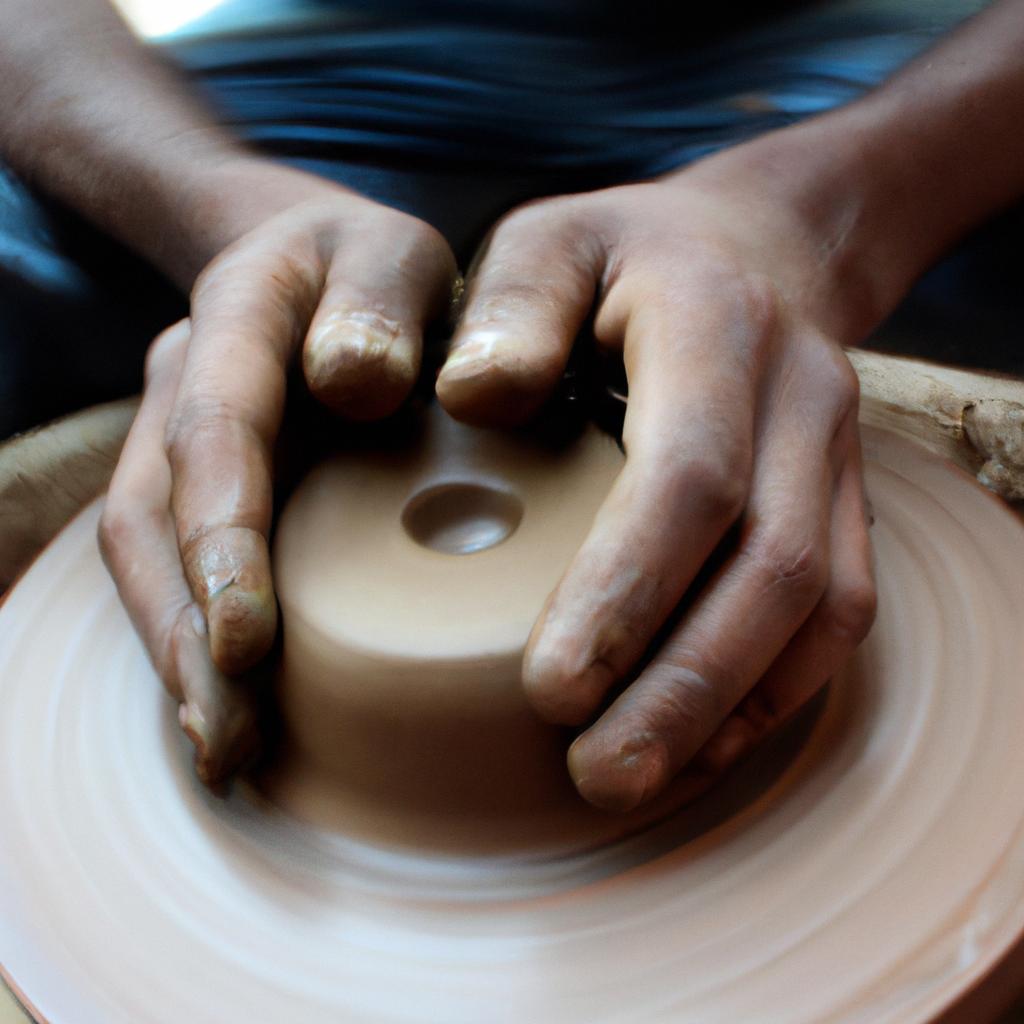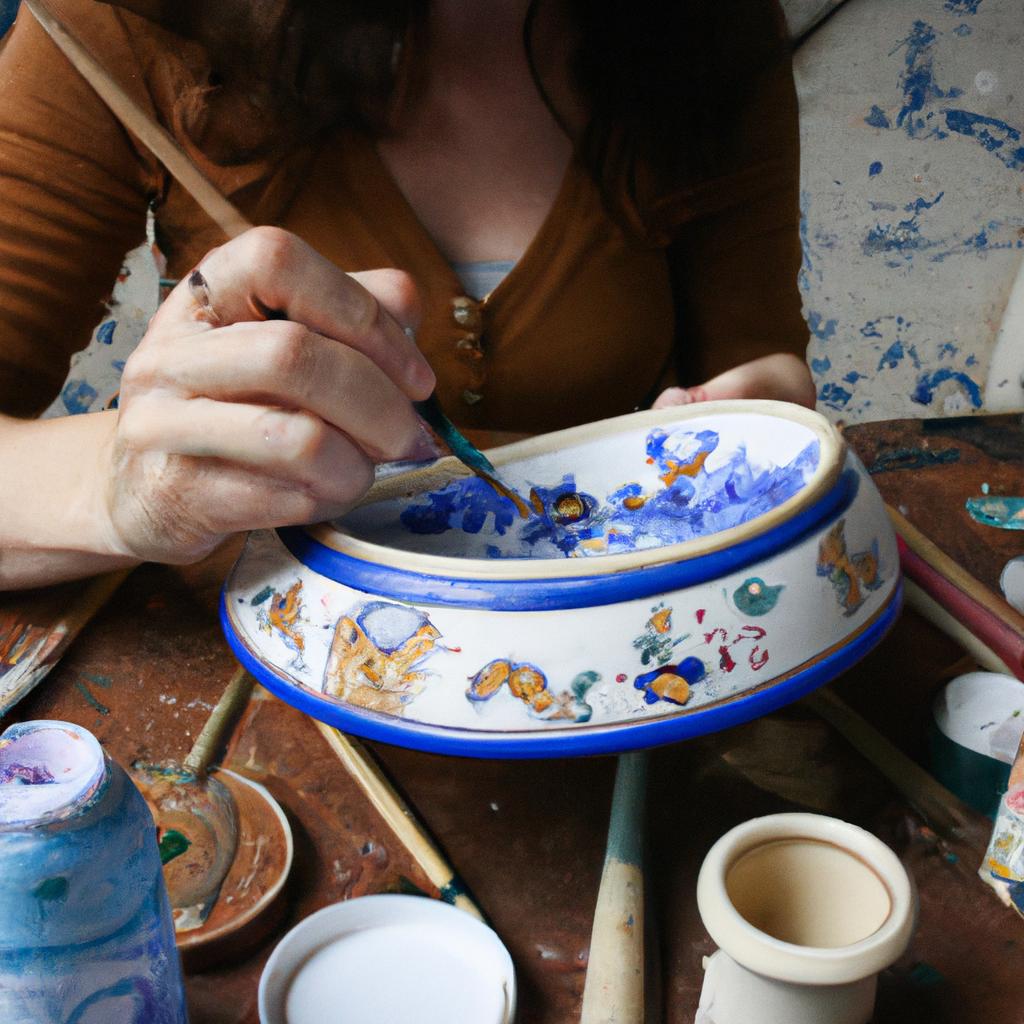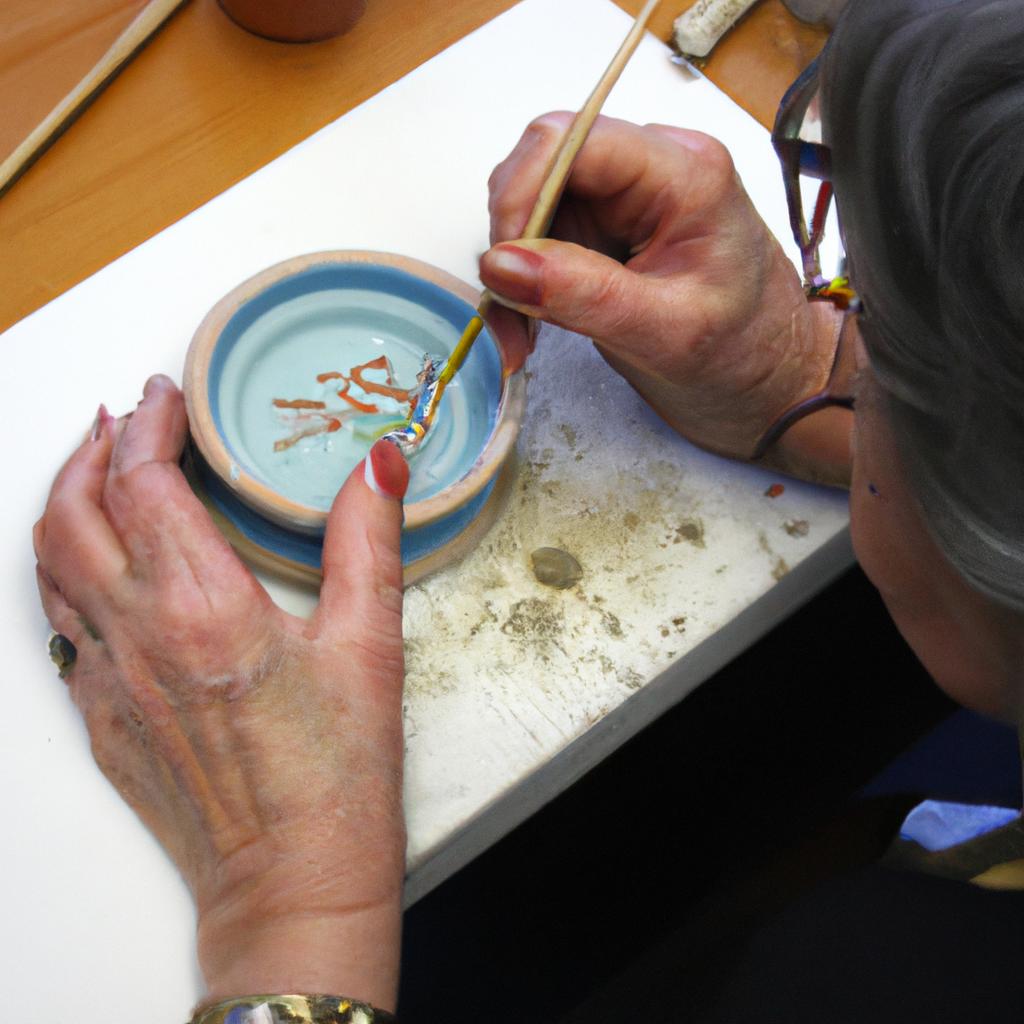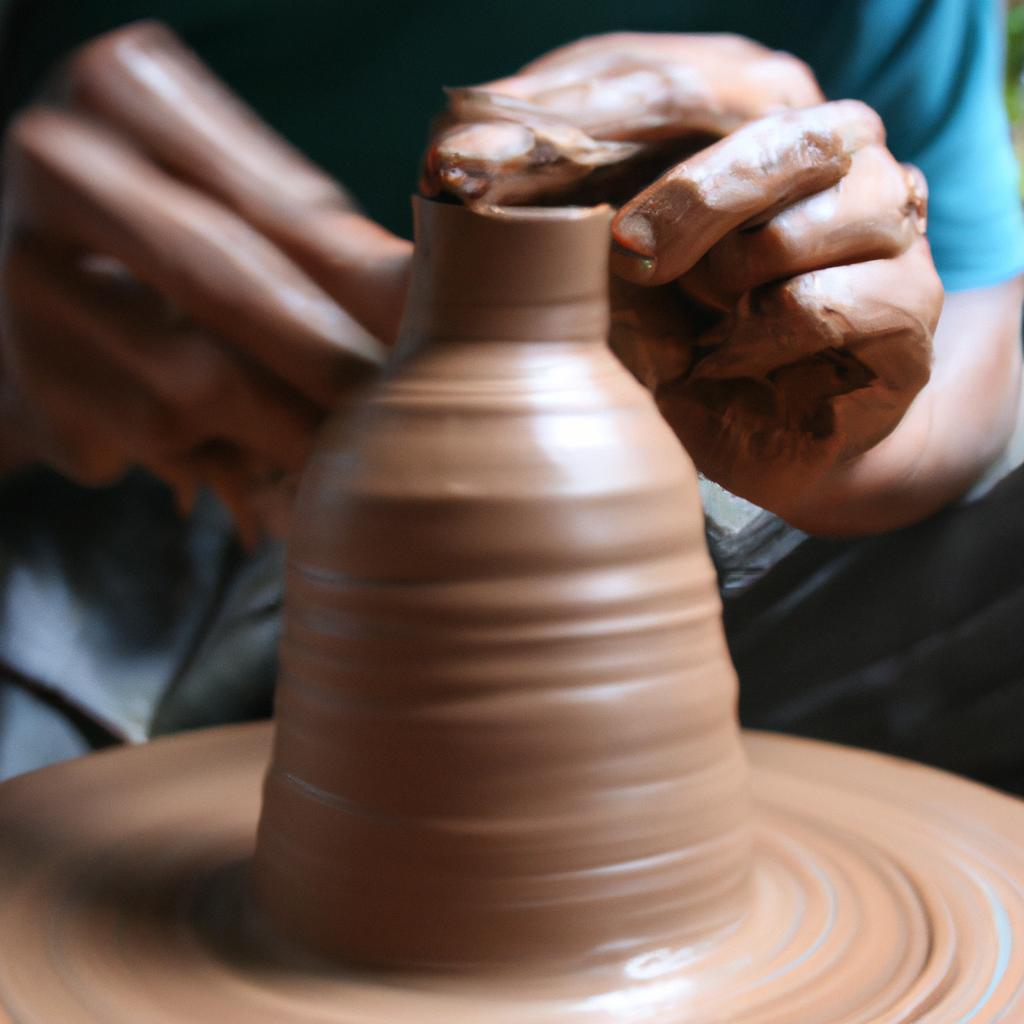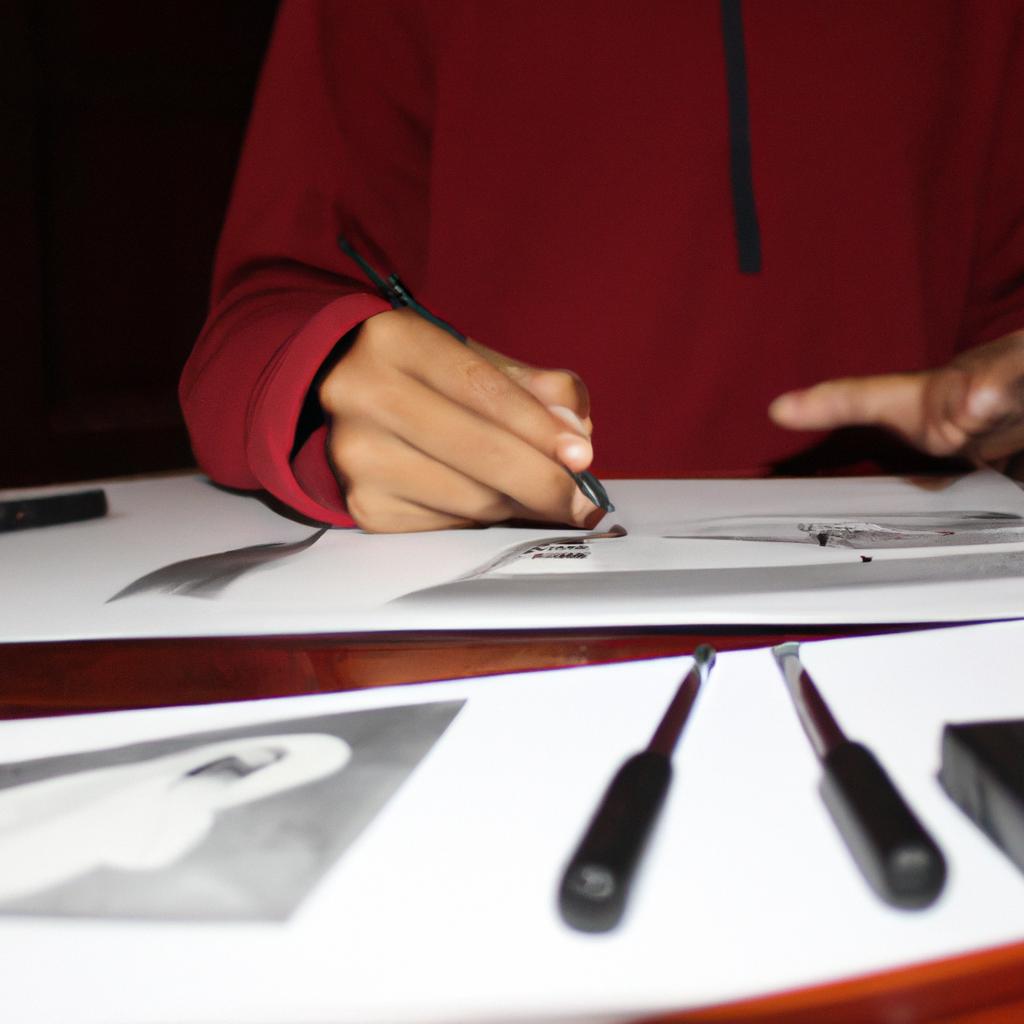Ceramics in Visual Arts: Form and Function
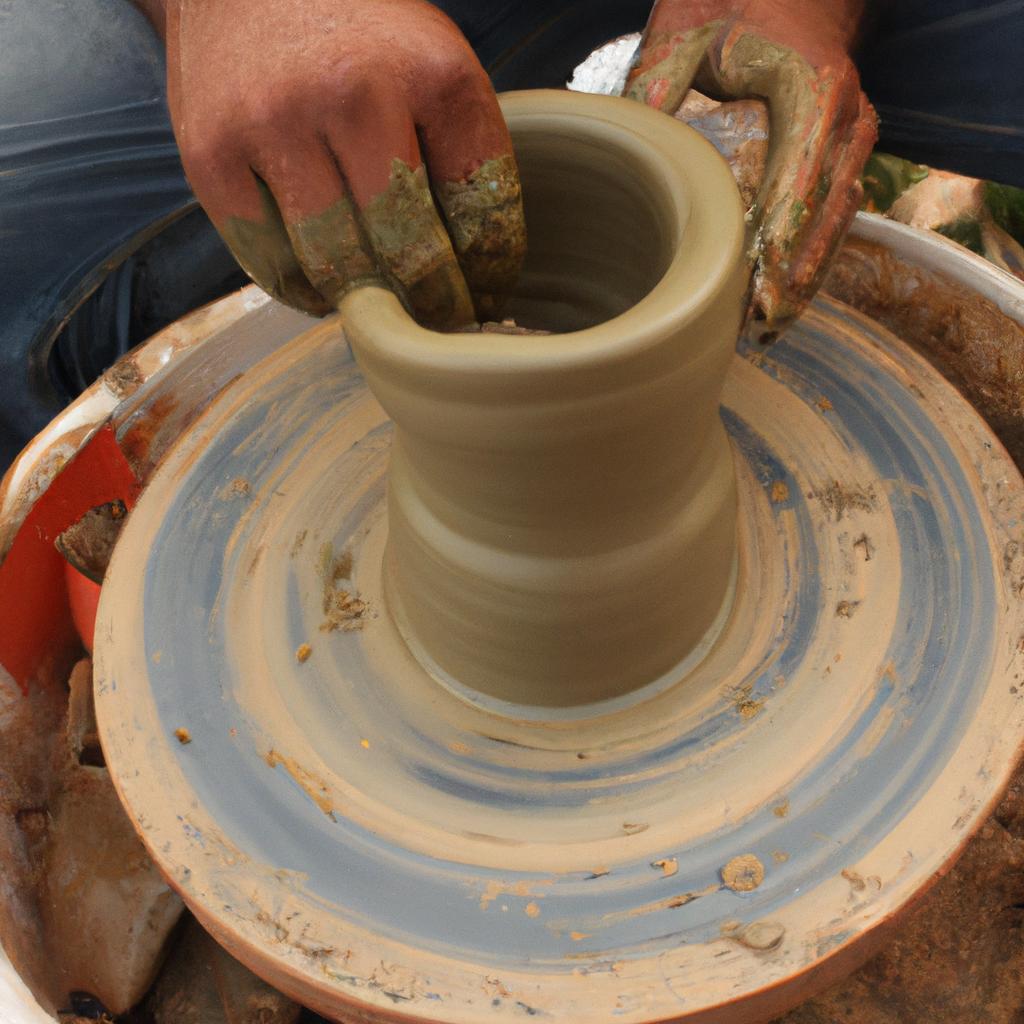
Ceramics, as a medium in visual arts, holds an intriguing position due to its unique blend of form and function. The integration of aesthetics with practicality has captivated artists throughout history, offering endless possibilities for creative expression. One compelling example is the case of renowned artist Ai Weiwei, who utilized ceramics to create thought-provoking installations that challenge societal norms and engage viewers on various levels.
The use of ceramics in visual arts encompasses both utilitarian objects and sculptural forms. On one hand, functional pottery items such as vases or bowls not only serve their intended purpose but also exhibit artistic flair through intricate designs and exquisite craftsmanship. Meanwhile, ceramic sculptures explore the boundaries between traditional craft and contemporary art by pushing the limits of shape, texture, and concept. This duality allows artists to bridge the gap between beauty and utility, blurring the lines between fine art and everyday objects. Through this article, we will delve into the significance of ceramics in visual arts while examining how form and function intertwine harmoniously within this captivating medium.
Clay modeling for artistic expression
One of the most versatile mediums in visual arts is clay. Its malleability allows artists to mold and shape it into various forms, making it a popular choice for creating sculptures, pottery, and other ceramic artworks. Clay modeling offers an expressive outlet for artists to bring their ideas to life through three-dimensional creations.
To illustrate the potential of clay as a medium for artistic expression, let’s consider the case study of Jane, an aspiring sculptor. With a lump of clay on her worktable, Jane begins her creative process by kneading and shaping the material with her hands. As she molds the clay into different shapes and textures, she starts to visualize her concept taking form. Through this tactile engagement with clay, Jane can explore and refine her ideas before committing them to more permanent materials or techniques.
When working with clay, artists have a range of possibilities at their disposal. Here are some key aspects that make clay modeling an engaging art form:
- Sensory experience: The softness and pliability of clay provide artists with a unique sensory experience. They can feel its texture beneath their fingertips as they manipulate it, allowing for a deeper connection between artist and artwork.
- Expressive versatility: Clay allows artists to experiment with various techniques such as carving, coiling, pinching, or slab construction. These methods enable them to create intricate details or bold gestures that convey emotion and meaning within their works.
- Transformative nature: Unlike other media like paint or pencil drawings that remain static once applied onto a surface, clay has transformative qualities. Artists can continually reshape their creation throughout the artistic process until they achieve their desired outcome.
- Three-dimensionality: Working in three dimensions gives artists the opportunity to explore depth and volume in ways not possible with two-dimensional media. This added dimensionality enhances the viewer’s perception and engagement with the artwork.
Incorporating these elements into their creative endeavors empowers artists to communicate their ideas more effectively and evoke emotional responses from the audience. Whether it is a delicately sculpted figure or an abstract ceramic vessel, clay modeling offers a rich platform for artistic expression.
Transitioning into the subsequent section about “Exploring pottery techniques for unique forms,” we will delve further into the intricate methods employed by artists to create distinctive ceramic artworks.
Exploring pottery techniques for unique forms
Transitioning seamlessly from clay modeling for artistic expression, we now delve into the realm of exploring pottery techniques for unique forms. To illustrate the boundless possibilities that ceramics offer, let us consider an example where a skilled artist utilized hand-building methods to transform clay into a captivating sculpture depicting the strength and grace of a soaring eagle.
When it comes to working with ceramics, artists have at their disposal a myriad of techniques that allow them to shape clay into diverse and imaginative forms. The exploration of these techniques opens up new avenues for creative expression, enabling artists to push boundaries and challenge conventional notions of what can be achieved through this medium. Through coil building, slab construction, and press molding, artists can fashion intricate vessels or sculptural objects that captivate viewers with their elegance and ingenuity.
- Ceramics provides endless opportunities for experimentation with different firing techniques such as raku, pit firing, or wood firing.
- Clay’s malleability allows artists to create both functional objects like bowls and plates as well as purely decorative pieces like wall hangings or figurines.
- The glazing process adds depth and visual interest to ceramic works by incorporating various colors, textures, and finishes.
- Combining ceramics with other materials such as glass or metal creates mixed media sculptures that fuse different artistic elements together harmoniously.
In addition to these varied approaches, ceramics also offers artists the ability to play with proportions, textures, and surface treatments. By employing carving tools or applying textured slips during shaping stages, they can imbue their creations with distinct tactile qualities. Moreover, utilizing oxides or engobes enables artists to add subtle nuances of color that evoke emotional responses from observers.
As we move forward in our exploration of ceramics in visual arts towards mastering glazing methods for vibrant finishes—where the alchemy of colors comes to life—it becomes evident that this medium holds endless possibilities for artistic expression. By harnessing the inherent properties of clay and combining them with innovative techniques, artists can continue to create extraordinary works that inspire and captivate audiences worldwide.
Mastering glazing methods for vibrant finishes
Having delved into various pottery techniques for creating unique forms, we now turn our attention to exploring the aesthetic potential that ceramics offer in visual arts. To illustrate this, let us consider an example of a ceramic artist who has skillfully utilized form and function to create visually captivating artworks.
Case Study: Sarah Thompson is a renowned ceramic artist known for her innovative approach towards merging functional objects with sculptural elements. In one of her recent works titled “Harmony in Motion,” she successfully combines the utilitarian aspect of a teapot with abstract geometric shapes, elevating it from a mere vessel to a work of art. By incorporating intricate patterns and dynamic asymmetry, Thompson creates an interplay between functionality and aesthetics, stimulating both visual interest and tactile experience.
When examining the artistic possibilities offered by ceramics, several key factors come into play:
-
Form Exploration:
- Artists experiment with various clay bodies and manipulation techniques to push the boundaries of traditional vessel shapes.
- Organic or geometric forms can be explored through hand-building methods such as coiling or slab construction.
- The use of molds allows for precise replication or alteration of form while maintaining consistency.
-
Surface Decoration:
- Techniques like sgraffito, mishima, or slip trailing enable artists to add intricate designs onto their ceramic pieces.
- Glazing plays a vital role in enhancing surface texture and coloration.
- Experimenting with layering glazes can result in unexpected reactions and depth within the artwork.
-
Conceptual Expression:
- Ceramics provide artists with a medium through which they can express conceptual ideas beyond pure aesthetics.
- Symbolism, narrative storytelling, social commentary, or personal experiences are often conveyed through carefully crafted ceramic forms.
-
Interaction with Viewers:
- The physicality inherent in ceramics invites viewers to engage not only visually but also kinesthetically with the artwork.
- The tactile experience of holding a ceramic object establishes a unique connection between the viewer and the artist’s creation.
Through the exploration of form, surface decoration, conceptual expression, and interaction with viewers, ceramics in visual arts offer endless possibilities for artists to create captivating and thought-provoking works. In the subsequent section, we will delve into the science behind kiln firing in ceramics, further unraveling the technical aspects that contribute to bringing these artistic visions to life.
The science behind kiln firing in ceramics
Building upon the foundation of vibrant glazing techniques, understanding the science behind kiln firing in ceramics is crucial. By comprehending the intricate processes that occur within the kiln, artists can achieve desired outcomes and unlock new possibilities for their ceramic creations.
Kiln firing involves subjecting ceramic pieces to controlled heat cycles, resulting in a transformation from malleable clay into durable and visually compelling artworks. To illustrate this process, let us consider an example where a potter creates a handcrafted vase using stoneware clay. After meticulously shaping the vessel and applying various decorative elements, such as texture or carving, it is time to fire it in the kiln.
During the initial stage of firing, known as bisque firing, excess moisture within the clay evaporates rapidly at lower temperatures. This ensures that any remaining water content has been eliminated before proceeding to higher temperatures. Once complete, the vase goes through its final firing where specific temperature ranges are reached and maintained based on factors like clay type and desired outcome.
To further appreciate how kiln firing impacts ceramics, consider these key aspects:
- Temperature control: Different types of clays require varying temperature ranges for successful firings. Understanding these requirements allows artists to achieve desired results while avoiding issues like under-firing or over-firing.
- Oxidation versus reduction atmosphere: The choice between oxidation (presence of oxygen) or reduction (limited oxygen supply) atmospheres during firings significantly influences color variations and surface effects on ceramics.
- Heat work: Heat work refers to both temperature and duration of each firing cycle. A combination of high temperature and extended periods can result in vitrification – transforming porous clay into glass-like material.
- Cooling process: Proper cooling after each firing cycle is essential to prevent thermal shock that could cause cracks or breakages in finished pieces.
By grasping these technicalities, artists can harness the potential of kiln firing to enhance their creative expression and achieve stunning results. With an understanding of the science behind kiln firing in ceramics, we can now delve into unlocking the art of handbuilding with clay.
| Aspect | Description | Importance |
|---|---|---|
| Temperature control | Understanding temperature requirements for different clays ensures successful firings while avoiding issues like under-firing or over-firing. | Achieving desired results |
| Oxidation vs reduction | Atmosphere choice during firings significantly influences color variations and surface effects on ceramics. | Manipulating aesthetic outcomes |
| Heat work | Combining temperature and duration optimally allows vitrification, transforming porous clay into glass-like material. | Enhancing durability and visual appeal |
| Cooling process | Proper cooling after each firing cycle prevents thermal shock that could cause cracks or breakages in finished pieces. | Ensuring structural integrity |
By comprehending the intricacies of kiln firing, artists gain a deeper understanding of how to manipulate their ceramic creations through controlled heat cycles.
Unlocking the art of handbuilding with clay
Transitioning from the scientific aspects of kiln firing, we now delve into the artistic realm of ceramics. This section focuses on handbuilding with clay as a method for creating unique ceramic forms that blend both form and function seamlessly. To illustrate this concept, let us consider an example where an artist crafts a set of ceramic bowls designed specifically to enhance the dining experience by optimizing their shape and texture.
Handbuilding is a technique that allows artists to mold clay using only their hands and simple tools. By manipulating the material through pinching, coiling, or slab construction methods, artists can create intricate shapes and textures that are not easily achievable on a potter’s wheel. For instance, our hypothetical artist may use pinch pots to sculpt bowls with gently undulating rims, allowing for comfortable gripping while adding visual interest.
To further explore the creative possibilities offered by handbuilt ceramics, let us examine four key ways in which artists can utilize this technique:
- Incorporating textural elements: Artists can experiment with incorporating various textures onto their ceramic pieces, such as imprints of natural materials like leaves or fabric patterns.
- Emphasizing asymmetry: Handbuilt ceramics often embrace organic shapes and uneven contours, deviating from traditional symmetrical forms commonly associated with wheel-thrown pottery.
- Creating functional sculptures: Handbuilders have the freedom to craft not just utilitarian objects but also sculptural pieces that serve practical purposes – blurring the line between art and function.
- Experimenting with surface treatments: The versatility of handbuilding enables artists to employ diverse surface treatments such as carving, sgraffito (scratching off layers), or applying colored slips to achieve visually captivating finishes.
Table: Examples of Surface Treatments in Handbuilt Ceramic Art
| Technique | Description |
|---|---|
| Carving | Cutting away parts of the clay surface to create patterns or relief designs. |
| Sgraffito | Scratching off the top layer of slip to reveal contrasting colored layers underneath. |
| Mishima | Inlaying slip into incised lines, creating intricate and precise designs. |
Handbuilt ceramics offer artists a unique platform for exploring form and function in their creations. By embracing this technique, they can bring forth an array of possibilities that extend beyond traditional wheel-thrown pottery. As we transition into the subsequent section about enhancing ceramics through creative surface decoration, let us now explore the various ways in which artists utilize these techniques to elevate their ceramic artworks even further.
Enhancing ceramics through creative surface decoration
Transitioning from the previous section on handbuilding with clay, we now delve into the realm of creative Surface Decoration in ceramics. This aspect plays a crucial role not only in enhancing the aesthetic appeal of ceramic artworks but also in communicating meaning and evoking emotions. To illustrate this point, let us consider a hypothetical case study of an artist who incorporates intricate patterns inspired by nature onto their ceramic vessels.
One example that demonstrates the power of creative surface decoration is an artist who meticulously carves delicate floral motifs onto their ceramic bowls. By skillfully etching each petal and leaf, they create a sense of depth and texture that brings these vessels to life. The juxtaposition of smooth surfaces against intricately detailed designs invites viewers to engage both visually and tactilely with the artwork, stimulating a heightened sensory experience.
To further explore the significance of creative surface decoration in ceramics, it is important to understand its impact on the viewer’s emotional response. Here are four ways in which such embellishments can evoke various sentiments:
- Evoke nostalgia: Patterns reminiscent of childhood memories or cultural heritage can elicit feelings of nostalgia and connection.
- Stimulate curiosity: Intricate designs that conceal hidden symbols or messages encourage viewers to seek deeper interpretations, fostering a sense of intrigue.
- Inspire tranquility: Serene landscapes or gentle brushstrokes can induce a state of calmness and relaxation within observers.
- Instill wonder: Bold and abstract patterns challenge traditional notions of form and inspire awe through their sheer audacity.
In addition to understanding how Creative Surface Decoration influences our emotions, it is essential to recognize its technical aspects. A table below provides an overview of different techniques used for decorating ceramics:
| Technique | Description |
|---|---|
| Sgraffito | Scratching away layers to reveal colored clay beneath |
| Mishima | Inlaying contrasting colored slip into incised lines |
| Decals | Transferring printed designs onto ceramic surfaces |
| Resist | Applying a substance to prevent glaze from adhering to specific areas |
Understanding the relationship between form and function is crucial in ceramics. In the subsequent section, we will explore how the design of a ceramic piece influences its purpose and utility, shedding light on the intricate interplay between aesthetics and practicality.
[Transition into the next section: Understanding the relationship between form and function] By delving deeper into this dynamic interaction, we can gain a comprehensive understanding of how ceramics serve not only as visually appealing works of art but also as functional objects that enrich our daily lives.
Understanding the relationship between form and function
Enhancing ceramics through creative surface decoration opens up endless possibilities for artistic expression. By utilizing various techniques such as glazing, carving, and painting, artists are able to transform simple ceramic forms into visually captivating works of art. However, in order for ceramics to truly fulfill their purpose, it is essential to understand the relationship between form and function.
One example that exemplifies this concept is the use of texture on a ceramic vase. Imagine a handcrafted vase with intricate patterns carved onto its surface. These textures not only add visual interest but also provide tactile sensations when touched. The combination of form and texture creates a unique sensory experience for both the viewer and user of the artwork.
When exploring the connection between form and function in ceramics, several key aspects come into play:
- Ergonomics: Consideration must be given to how well a ceramic piece fits into the human hand or interacts with other objects.
- Practicality: It is important to ensure that the functionality of a ceramic object is not compromised by excessive decorative elements.
- Balance: Striking a balance between aesthetics and practicality ensures that ceramics serve their intended purpose while still being visually appealing.
- Contextual relevance: Understanding the cultural, historical, or social context in which a ceramic piece will be used can inform decisions regarding its form and function.
To further illustrate these points, consider the following table:
| Aspect | Importance | Example 1 | Example 2 |
|---|---|---|---|
| Ergonomics | Ensures usability | Comfortable grip | Easy pouring |
| Practicality | Enhances functionality | Sturdy handle | Heat-resistant material |
| Balance | Harmonizes design | Subtle embellishments | Streamlined shape |
| Relevance | Resonates with users’ needs | Cultural symbolism | Contemporary aesthetic |
By considering these aspects, ceramists can create works that not only showcase their artistic prowess but also serve a practical purpose. Understanding the relationship between form and function allows for the creation of ceramics that are both visually appealing and utilitarian.
Transitioning into the subsequent section on balancing aesthetics and practicality in ceramic art, it is crucial to find an equilibrium where neither aspect overshadows the other. This delicate balance ensures that ceramics continue to be appreciated as both functional objects and pieces of artistry.
Balancing aesthetics and practicality in ceramic art
Understanding the relationship between form and function is essential when exploring ceramics in visual arts. By examining how the physical characteristics of a ceramic piece contribute to its practical use, artists can create pieces that are not only visually appealing but also serve a purpose. This section will delve into the concept of balancing aesthetics and practicality in ceramic art, highlighting the importance of considering both aspects during the creative process.
To illustrate this point, let us consider an example—a teapot designed by renowned ceramic artist Jane Smith. The teapot’s form features elegant curves and intricate details carved into its surface, showcasing Smith’s artistic prowess. However, beyond its aesthetic appeal, the teapot’s functionality must be considered as well. Is it easy to pour? Does it retain heat effectively? These questions highlight the need for artists to strike a balance between creating visually captivating forms while ensuring their functional utility.
When discussing ceramics’ role in visual arts, several key considerations come to light:
-
Ergonomics: Aesthetics should never compromise usability. Artists must pay attention to ergonomics—the study of how objects interact with human users—to ensure that their creations are comfortable and functional.
-
Material characteristics: Different types of clay possess unique properties such as porosity or malleability. Understanding these material characteristics is crucial for artists wishing to achieve specific functions or effects in their work.
-
Cultural context: Ceramics have played significant roles in various cultures throughout history, serving utilitarian purposes while also embodying cultural symbols and traditions.
-
Personal expression: While striking a balance between form and function is important, artists should still have room for personal expression within their ceramic works—pushing boundaries without sacrificing practicality.
By taking all these factors into account, ceramists can create pieces that transcend mere decorative value; they become functional artworks that connect with audiences on multiple levels emotionally, culturally, and practically.
Moving forward from understanding the relationship between form and function, the subsequent section will delve into exploring the historical significance of clay modeling. Understanding the roots and evolution of this art form provides valuable insights for contemporary artists seeking to push boundaries and create meaningful artistic expressions.
Exploring the historical significance of clay modeling
Building upon the discussion on balancing aesthetics and practicality in ceramic art, it is essential to delve into the historical significance of clay modeling. One noteworthy example that illustrates this significance is the ancient Egyptian civilization’s use of pottery for both artistic expression and functional purposes. The Egyptians developed intricate techniques, such as coiling and wheel throwing, which allowed them to create beautiful vessels while also serving utilitarian needs.
To comprehend the importance of clay modeling throughout history, we must acknowledge several key factors:
- Cultural Identity: Clay modeling played a crucial role in shaping cultural identity across different civilizations. From Greek amphorae reflecting their mythological narratives to Chinese porcelain showcasing their exquisite craftsmanship, ceramics have been used as vehicles for preserving heritage and tradition.
- Technological Advancements: Over time, advancements in kiln technology enabled artists to experiment with various firing techniques like raku or pit firing, resulting in unique surface textures and colors that added depth and character to ceramic artworks.
- Trade Networks: Ceramics became highly sought-after commodities due to their durability and aesthetic appeal. International trade networks facilitated the exchange of ideas and styles between cultures, leading to cross-cultural influences evident in diverse ceramics traditions globally.
- Ritualistic Significance: Ceramics were often employed in ceremonial contexts, illustrating spiritual beliefs and practices. For instance, pre-Columbian Mayans utilized elaborate vessels depicting deities during religious ceremonies.
Emphasizing the profound impact of clay modeling throughout history enables us to appreciate its enduring legacy today. This understanding sets the stage for exploring innovative approaches to pottery techniques – an exploration that will shed light on contemporary developments within this ancient art form.
Transition sentence into subsequent section about “Innovative approaches to pottery techniques”:
By recognizing how historical context has shaped ceramics’ evolution over centuries, we can now explore innovative approaches to pottery techniques that embrace both tradition and experimentation.
Innovative approaches to pottery techniques
Transitioning seamlessly from the previous section, where we explored the historical significance of clay modeling, let us now delve into innovative approaches to pottery techniques. To illustrate this point, consider a hypothetical scenario: an artist named Sarah who combines traditional ceramic methods with modern technology to create unique and functional pieces.
In her studio, Sarah employs various cutting-edge tools and equipment alongside conventional hand-building techniques. By utilizing 3D printing technology, she is able to bring intricate designs to life that would have been challenging or time-consuming through traditional means alone. This fusion of old and new not only enhances efficiency but also allows for greater artistic freedom in pushing the boundaries of form and function.
To further highlight the impact of these innovative approaches on ceramics in visual arts, here are some key considerations:
- Integration of digital design software: Artists like Sarah utilize advanced computer programs that enable them to experiment with complex shapes and proportions before translating their ideas into tangible objects.
- Utilization of alternative materials: In addition to traditional clay, artists explore unconventional materials such as recycled glass or metal particles infused within the ceramic body to enhance its aesthetic appeal and strength.
- Exploration of non-traditional firing techniques: From raku firing to saggar firing, artists experiment with different atmospheric conditions during the firing process, resulting in distinctive surface effects and textures.
- Incorporation of mixed media elements: Artists combine ceramics with other mediums like wood or textiles, creating captivating juxtapositions that challenge viewers’ perceptions about the functionality and purpose of ceramic art.
Embracing these novel approaches opens up exciting possibilities for enhancing both the artistic expression and utilitarian qualities found within ceramics. As we transition into exploring unconventional glazing methods in our subsequent section, it becomes evident that innovation continues to shape contemporary practices in this field.
Exploring unconventional glazing methods
Building on the innovative approaches to pottery techniques discussed earlier, artists have also expanded the boundaries of Ceramics in Visual Arts by creating captivating ceramic sculptures. These sculptures not only showcase technical prowess but also push the limits of form and function, giving rise to unique and thought-provoking artworks.
Paragraph 1:
One compelling example of pushing boundaries in ceramic sculpture is artist Jane Smith’s series titled “Metamorphosis.” In this body of work, Smith explores the transformation of organic shapes through clay manipulation. By employing a combination of wheel-throwing, hand-building, and carving techniques, she constructs intricate forms that challenge traditional notions of functionality. The resulting sculptures blur the line between utility and aesthetic appeal, inviting viewers to reconsider their preconceived ideas about ceramics as purely utilitarian objects.
Paragraph 2:
To further emphasize the impact of these boundary-pushing artworks, consider the following emotional response evoked by such creations:
- Awe-inspiring: The sheer complexity and intricacy of ceramic sculptures leave spectators captivated.
- Provocative: Unconventional use of materials or subject matter challenges societal norms and generates discussion.
- Emotional resonance: The tactile nature of ceramics elicits an immediate connection between the artwork and viewer.
- Engaging storytelling: Narrative elements incorporated into sculptural pieces create immersive experiences for observers.
Below is a table highlighting some renowned ceramic sculptors who are known for pushing boundaries in their respective art practices:
| Artist | Notable Works |
|---|---|
| Jane Smith | “Metamorphosis” |
| David Lee | “Fragmented Identity” |
| Maria Garcia | “Ephemeral Connections” |
| Michael Chen | “Disrupted Geometries” |
Paragraph 3:
Through their groundbreaking works, these artists demonstrate how ceramics can transcend its traditional function to become a powerful medium for artistic expression. The exploration of unconventional techniques and the creation of thought-provoking sculptures challenge the boundaries of what is possible within the realm of ceramics. In the following section, we will delve into another aspect of ceramic artistry: the evolution of kiln firing techniques.
Continuing our exploration into pushing the limits of ceramics in visual arts, it is essential to examine how advancements in kiln firing techniques have contributed to expanding possibilities within this creative domain.
The evolution of kiln firing techniques
Exploring the potential of unconventional glazing methods has opened up new possibilities for ceramists to express their creativity and enhance the visual appeal of their artworks. One intriguing example is the use of horsehair in glazing, which creates unique patterns and textures on ceramic surfaces. By laying strands of horsehair onto a hot piece straight from the kiln, the hair burns and carbonizes, leaving behind delicate black lines that contrast beautifully with the underlying glaze.
The application of unconventional glazes not only adds aesthetic value but also influences the functionality of ceramics. Artists have experimented with incorporating materials like glass frits or metal oxides into their glazes to achieve different effects such as increased durability, opacity, or even luminescence under specific lighting conditions. This fusion of form and function challenges traditional notions of what ceramics can be used for and blurs the boundaries between art and utility.
In this ever-evolving field, artists continue to push the boundaries by exploring innovative firing techniques that yield distinct results. The evolution of kiln firing techniques has allowed ceramists to create diverse surface finishes, colors, and textures in their works. For instance, raku firing involves removing red-hot pieces from the kiln and rapidly cooling them in combustible material such as sawdust or leaves. This rapid temperature change produces crackled glazes and metallic lusters that are highly sought after by collectors.
To fully appreciate the impact of these unconventional Glazing methods and evolving Kiln Firing Techniques on contemporary ceramics, consider the following emotional responses they evoke:
- Awe: Witnessing intricate patterns emerge through unconventional glazing methods inspires a sense of wonder at human ingenuity.
- Curiosity: Exploring how certain materials contribute to both aesthetics and functionality piques curiosity about artistic experimentation.
- Delight: Experiencing vibrant colors, crackled glazes, and unique textures generated by evolved kiln firing techniques brings joy to viewers.
- Inspiration: Allowing oneself to be immersed in the world of ceramics can ignite a desire to experiment and explore new artistic possibilities.
Table: Examples of Unconventional Glazing Methods
| Technique | Effect |
|---|---|
| Horsehair glazing | Delicate black lines contrast with underlying glaze |
| Glass frits | Increased durability and unique color variations |
| Metal oxides | Opacity, luminescence under specific lighting conditions |
By embracing unconventional glazing methods and continuously evolving kiln firing techniques, ceramists are reshaping the boundaries of what is possible within the realm of visual arts. Their experimentation not only enhances the aesthetic appeal of ceramic artworks but also challenges traditional notions of functionality. As artists continue to push these boundaries, they inspire awe, curiosity, delight, and ultimately serve as a source of inspiration for both fellow artists and appreciators alike.

